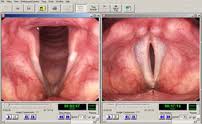 I’ve devoted several episodes of VoiceBox, the weekly public radio series on KALW 91.7 FM all about the human voice which I host and produce, to the subject of voice therapy. But all the conversation about nodes on the vocal folds, dealing with fatigue by maintaining good airflow and how voice changes with age didn’t hit home until I visited the University of California at San Francisco’s Voice and Swallowing Center yesterday for a consultation with vocal therapist Sarah Schneider (whose been my guest on VoiceBox three times to date) and otolaryngologist, Dr. Mark Courey.
I’ve devoted several episodes of VoiceBox, the weekly public radio series on KALW 91.7 FM all about the human voice which I host and produce, to the subject of voice therapy. But all the conversation about nodes on the vocal folds, dealing with fatigue by maintaining good airflow and how voice changes with age didn’t hit home until I visited the University of California at San Francisco’s Voice and Swallowing Center yesterday for a consultation with vocal therapist Sarah Schneider (whose been my guest on VoiceBox three times to date) and otolaryngologist, Dr. Mark Courey.
I think it behooves all singers, whether they have voice issues or not, to get their vocal folds checked out at least once in their singing careers. Because all the apparatus involved with singing is internal, it really helps to be able to see first-hand with your own eyes how the mechanisms actually work.
In my consultation, Sarah felt my adam’s apple and throat muscles, photographed my profile while I read out a “phonetically balanced” passage (ie one where the sentences are chosen so that the various segmental phonemes of English are represented in accordance with their frequency of occurrence) and, best of all, performed a videostroboscopy on my vocal chords while I sang various parts of the major scale to different vowel sounds.
It was absolutely fascinating (and mildly shocking) to see my vocal folds opening and closing like the mouth of some ancient sea creature grazing for plankton on the ocean floor. I learned a lot about how the voice works and have a better grasp of the issues that I face with my voice at the moment.
The session ended with a consultation with Dr. Courey. I don’t think I will ever view the activity of singing in the same way again.
